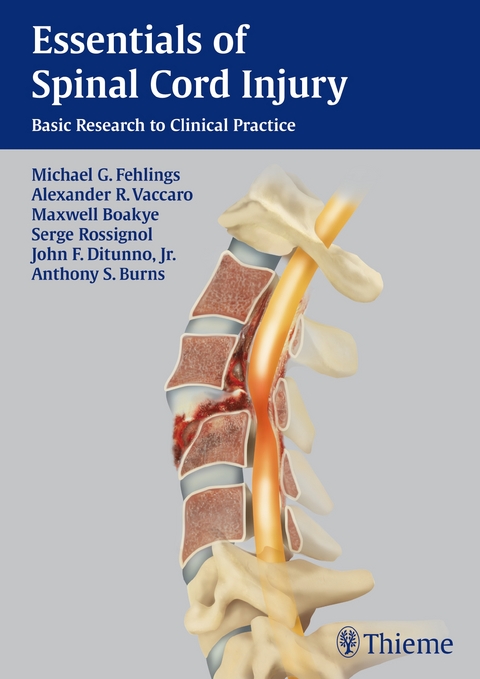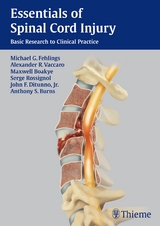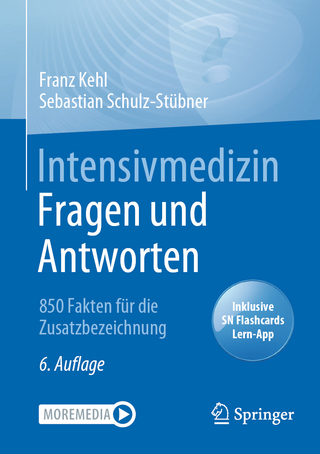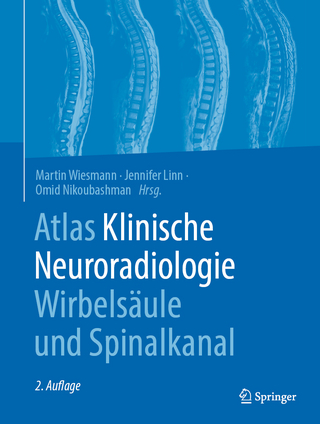Essentials of Spinal Cord Injury
Thieme Medical Publishers Inc (Verlag)
978-1-60406-726-2 (ISBN)
Essentials of Spinal Cord Injury is written for the spinal cord injury (SCI) team and reflects the multidisciplinary nature of treating patients with SCI. It integrates emerging medical and surgical approaches to SCI with neuroanatomy, neurophysiology, neuroimaging, neuroplasticity, and cellular transplantation. This comprehensive yet concise reference will enable neurosurgeons, orthopedic surgeons, neurologists, and allied health professionals caring for SCI patients to translate research results into patient care. It is also an excellent resource for those preparing for the board exam in SCI medicine.
Key Features:
This is a must-have guide that all neurosurgeons, orthopedic surgeons, neurologists, and allied health professionals involved in the care of spinal cord injury patients should have on their bookshelf.
Medical DirectorSpinal Cord Rehabilitation ProgramLyndhurst Centre, Toronoto Rehabilitation Institute
Diagnosis and Clinical management
1. Anatomy and physiology of the spinal cord
2. Evaluation of the patient with spinal cord injury
3. Pathophysiology of spinal cord injury
4. Epidemiology of spinal cord injury, trends, in-hospital complication rates late complications, factors affecting outcome
5. Spontaneous recovery patterns after SCI
6. Classification of Spinal Cord Injuries
7. Acute Spinal cord injury, ICU management
8. Management of concomitant head injury and spinal cord injury
9. Pharmacotherapy in acute and chronic SCI, i.e.the role of steroids
10. Halo application and closed skeletal reduction of cervical dislocations
11. The timing of surgery in acute spinal cord injury
12. Principles of surgical management of spinal trauma associated with spinal cord injury
13. DVT prophylaxis
14. Bowel and bladder management
15. Hemodynamic management in surgery and the ICU
16. Decubitus ulcers
17. Autonomic dysreflexia and cardiovascular complications of SCI
18. Neuropathic pain
19. Posttraumatic kyphotic deformities
20. Posttraumatic Syringomyelia and cord tethering
21. Rehabilitation of the spinal cord injured patient
22. Management of spasticity
23. The management of complications of chronic SCI
Controversies in management
24. current clinical and Evidence based guidelines
25. Timing of surgery-evidence based review
26. Hypothermia-evidence based review
27. Management of Cervical facet dislocation
28. The management of acute spinal cord injury in thoracolumbar burst fracture including cauda equine syndrome
29. Management of central cord syndrome
30. Methylprednislone-evidence based review
31. Timing and type of rehabilitation
Neuroprotective and NeuroRegenerative Approaches
32. Translational Research in Spinal cord Injury
33. Designing an effective translational research program in SCI
34. Building an infrastructure for effective clinical trial participation-initiating a clinical trial or participating
35. Guidelines for clinical trials
36. animal models of spinal cord injury
37. Immunological approaches
38. Pharmacological approaches
39. Cellular transplantation in SCI
40. Stem cell transplantation
41. Neuroregeneration approaches
42. Neuroprotective trials
43. Approaches using nanotechnology
44. Methods for Delivery of therapies
45. Enhancing Activity Dependent Plasticity
46. Quantitative tests of Sensory and Motor function and Autonomic Function
Neurophysiology and Imaging
47. neurophysiological methods-transcranial magnetic stimulation, somatosensory evoked potentials, electromyography, H-reflexes
48. Basic neurophysiological approaches to probing spinal circuits
49. neuroimaging-fmri after spinal cord injury, spinal fmri, spinal DTI, PET-CT, MRI
50. Role of neurophysiology in study of recovery and spasticity
Plasticity and recovery
51. Spinal and Supraspinal plasticity and recovery
52. Central pattern generator and role in SCI recovery
53. Somatosensory function and recovery
54. Activity based approaches
55. Neuromodulation in SCI-bladder stimulation, spinal cord stimulation, functional electrical stimulation, Brain computer interfaces, Role of epidural stimulation and oscillating fields
56. Rerouting injured spinal cord circuits with peripheral nerve grafts
Resources
57. SCI national database research
58. Summary of resources-internet, meetings, SCI organizations.
Achieving success
59. Twenty most critical research areas and questions.
60. Genomics and proteomics
61. Breakthroughs of the last twenty years
62. Strategies for success
Diagnosis and Clinical management
1. Anatomy and physiology of the spinal cord
2. Evaluation of the patient with spinal cord injury
3. Pathophysiology of spinal cord injury
4. Epidemiology of spinal cord injury, trends, in-hospital complication rates late complications, factors affecting outcome
5. Spontaneous recovery patterns after SCI
6. Classification of Spinal Cord Injuries
7. Acute Spinal cord injury, ICU management
8. Management of concomitant head injury and spinal cord injury
9. Pharmacotherapy in acute and chronic SCI, i.e.the role of steroids
10. Halo application and closed skeletal reduction of cervical dislocations
11. The timing of surgery in acute spinal cord injury
12. Principles of surgical management of spinal trauma associated with spinal cord injury
13. DVT prophylaxis
14. Bowel and bladder management
15. Hemodynamic management in surgery and the ICU
16. Decubitus ulcers
17. Autonomic dysreflexia and cardiovascular complications of SCI
18. Neuropathic pain
19. Posttraumatic kyphotic deformities
20. Posttraumatic Syringomyelia and cord tethering
21. Rehabilitation of the spinal cord injured patient
22. Management of spasticity
23. The management of complications of chronic SCI
Controversies in management
24. current clinical and Evidence based guidelines
25. Timing of surgery-evidence based review
26. Hypothermia-evidence based review
27. Management of Cervical facet dislocation
28. The management of acute spinal cord injury in thoracolumbar burst fracture including cauda equine syndrome
29. Management of central cord syndrome
30. Methylprednislone-evidence based review
31. Timing and type of rehabilitation
Neuroprotective and NeuroRegenerative Approaches
32. Translational Research in Spinal cord Injury
33. Designing an effective translational research program in SCI
34. Building an infrastructure for effective clinical trial participation-initiating a clinical trial or participating
35. Guidelines for clinical trials
36. animal models of spinal cord injury
37. Immunological approaches
38. Pharmacological approaches
39. Cellular transplantation in SCI
40. Stem cell transplantation
41. Neuroregeneration approaches
42. Neuroprotective trials
43. Approaches using nanotechnology
44. Methods for Delivery of therapies
45. Enhancing Activity Dependent Plasticity
46. Quantitative tests of Sensory and Motor function and Autonomic Function
Neurophysiology and Imaging
47. neurophysiological methods-transcranial magnetic stimulation, somatosensory evoked potentials, electromyography, H-reflexes
48. Basic neurophysiological approaches to probing spinal circuits
49. neuroimaging-fmri after spinal cord injury, spinal fmri, spinal DTI, PET-CT, MRI
50. Role of neurophysiology in study of recovery and spasticity
Plasticity and recovery
51. Spinal and Supraspinal plasticity and recovery
52. Central pattern generator and role in SCI recovery
53. Somatosensory function and recovery
54. Activity based approaches
55. Neuromodulation in SCI-bladder stimulation, spinal cord stimulation, functional electrical stimulation, Brain computer interfaces, Role of epidural stimulation and oscillating fields
56. Rerouting injured spinal cord circuits with peripheral nerve grafts
Resources
57. SCI national database research
58. Summary of resources-internet, meetings, SCI organizations.
Achieving success
59. Twenty most critical research areas and questions.
60. Genomics and proteomics
61. Breakthroughs of the last twenty years
62. Strategies for success
| Zusatzinfo | 177 Abb. |
|---|---|
| Verlagsort | New York |
| Sprache | englisch |
| Gewicht | 1724 g |
| Themenwelt | Medizinische Fachgebiete ► Chirurgie ► Neurochirurgie |
| Medizinische Fachgebiete ► Chirurgie ► Unfallchirurgie / Orthopädie | |
| Medizin / Pharmazie ► Medizinische Fachgebiete ► Neurologie | |
| Schlagworte | Boakye • Fehlings • Rückenmark • spinal cord injury • spine • Vaccaro |
| ISBN-10 | 1-60406-726-8 / 1604067268 |
| ISBN-13 | 978-1-60406-726-2 / 9781604067262 |
| Zustand | Neuware |
| Haben Sie eine Frage zum Produkt? |
aus dem Bereich




